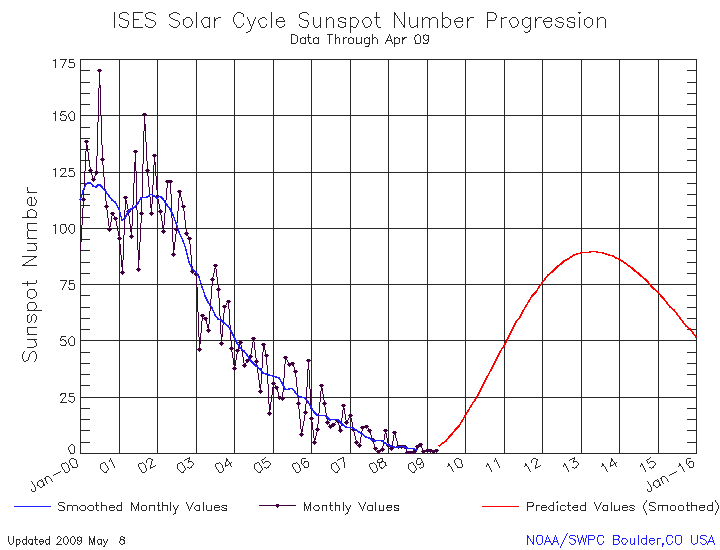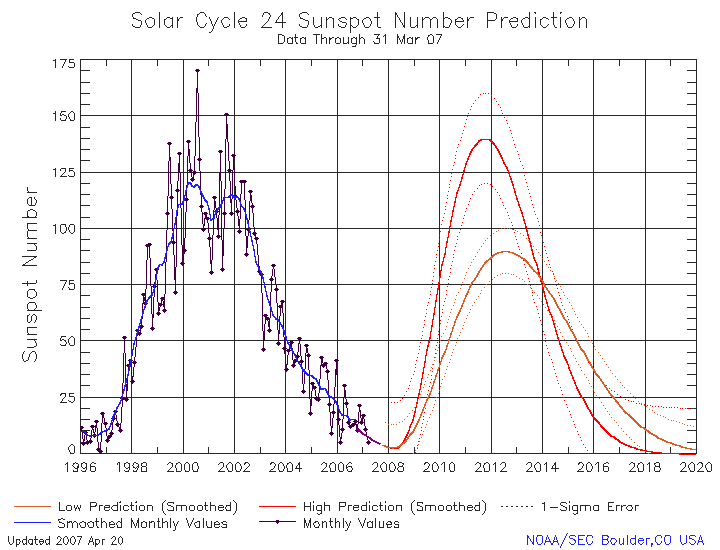Solar Cycle 24 Prediction Updated May 2009
Presented by the NOAA Space Weather Prediction Center (SWPC)
May 8, 2009 -- Solar Cycle 24 Prediction Update The Solar Cycle 24 Prediction Panel has reached a consensus decision on the prediction of the next solar cycle (Cycle 24). First, the panel has agreed that solar minimum occurred in December, 2008. This still qualifies as a prediction since the smoothed sunspot number is only valid through September, 2008. The panel has decided that the next solar cycle will be below average in intensity, with a maximum sunspot number of 90. Given the predicted date of solar minimum and the predicted maximum intensity, solar maximum is now expected to occur in May, 2013. Note, this is a consensus opinion, not a unanimous decision. A supermajority of the panel did agree to this prediction.
June 27, 2008 During the annual Space Weather Workshop held in Boulder, CO in May, 2008, the Solar Cycle 24 Prediction Panel released an update to the prediction for the next solar cycle. In short, the update is that the panel has not yet made any changes to the prediction issued in April, 2007. The panel expects solar minimum to occur in March, 2008. The panel expects the solar cycle to reach a peak sunspot number of 140 in October, 2011 or a peak of 90 in August, 2012.
April 25, 2008 The official NOAA, NASA, and ISES Solar Cycle 24 prediction was released by the Solar Cycle 24 Prediction Panel on April 25, 2007. The Prediction Panel included members from NOAA, NASA, ISES and other US and International representatives. Press Briefings and presentations at the SEC Space Weather Workshop, plus additional announcements and information from the Panel are linked below. The Panel expects to update this prediction annually.
The Panel considered all Predictions of Solar Cycle 24 they found in the literature or received directly from an author. The May 24, 2007 List shows the predictions considered.
May 2, 2008 Solar Cycle 24 Prediction presentation at the Space Weather Workshop.
April 25, 2007 NOAA Press Release
Press Briefing
Solar Cycles 24 Consensus Prediction – Douglas Biesecker, scientist, NOAA Space Environment Center; chair, Solar Cycle 24 Prediction Panel
NASA and Solar Cycle Predictions – W. Dean Pesnell, project scientist, Solar Dynamics Observatory, NASA Goddard Space Flight Center; member, Solar Cycle 24 Prediction Panel
Economic Impacts – Daniel Baker, director, Laboratory for Atmospheric and Space Physics, University of Colorado, Boulder; chair, Committee on Solar and Space Physics, National Research Council
Economic Impacts -- Layer 1 -- Layer 2 -- Layer 3
Solar Cycles
Space Studies Board Economic Impacts Study
Impacts of Space Weather on the Economy Joseph Kunches, chief, Forecast Center, NOAA Space Environment Center Consensus Statement of the Solar Cycle 24 Prediction Panel – March 2007
April 25, 2007 Solar Cycle 24 Prediction presentations at the SEC Space Weather Workshop
Solar Cycle 24 Consensus Prediction – Douglas Biesecker, NOAA, SEC
Societal and Economic Aspects of Space Weather – Daniel Baker, LASP/University of Colorado
Meeting the Challenges of Nature: The Impact of Space Weather on Marine Positioning Services – Richard Barker, Fugro Chance Inc
Why NASA Needs a Prediction of the Solar Cycle – W. Dean Pesnell, NASA GSFC
The Sun's Role in Past, Current and Future Climate Change – Caspar Ammann, NCAR CGD & HAO
News from the Solar Cycle 24 Prediction Panel -- Oct 2006

